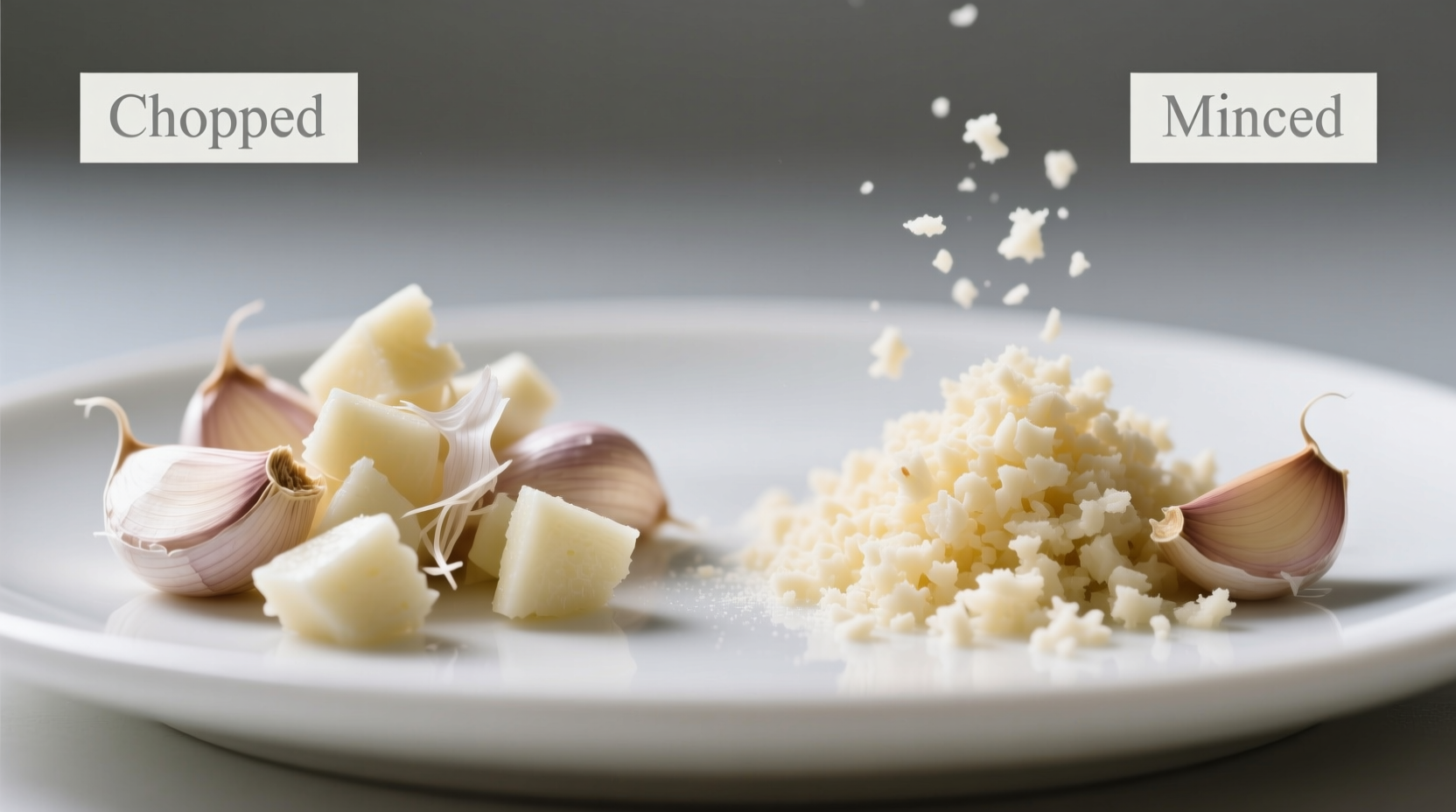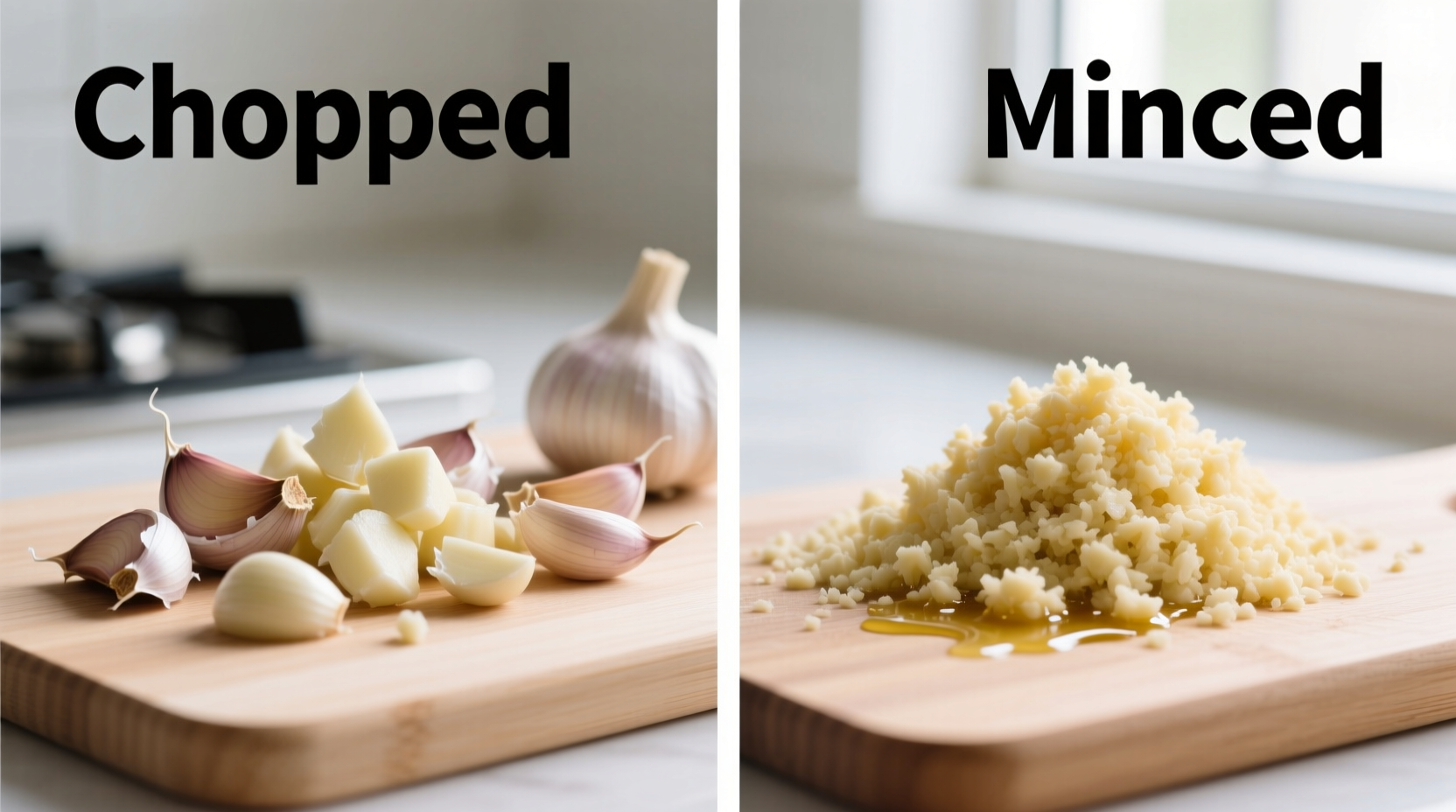Chopped garlic features larger, visible pieces (about 1/8 inch) that provide distinct garlic flavor bursts and visual texture, while minced garlic is finely diced (1/16 inch or smaller) for even flavor distribution without noticeable pieces. The difference significantly impacts cooking results: chopped garlic works best in slow-simmered dishes where you want visible garlic pieces, while minced garlic integrates seamlessly into quick-cooking recipes requiring uniform flavor.
Ever stared at a recipe calling for "minced garlic" when you've already chopped it? You're not alone. Understanding the practical difference between chopped and minced garlic transforms ordinary cooking into restaurant-quality results. This guide reveals exactly how these two preparations affect flavor, cooking time, and final dish quality—plus when you can substitute one for the other without ruining dinner.
What Exactly Separates Chopped from Minced Garlic?
While both start with peeled cloves, the critical distinction lies in particle size and surface area exposure. Professional chefs measure this difference precisely:
| Preparation | Average Size | Surface Area | Texture Description |
|---|---|---|---|
| Chopped garlic | 1/8 inch (3mm) | Moderate | Visible distinct pieces, irregular shapes |
| Minced garlic | 1/16 inch (1.5mm) or smaller | High | Nearly paste-like, uniform consistency |
This seemingly small difference creates dramatic changes in how garlic behaves during cooking. According to the USDA Food Composition Database, increased surface area exposes more allicin compounds—the source of garlic's flavor—which explains why minced garlic delivers more intense flavor faster.

Flavor Science: Why Size Matters in Your Pan
Garlic's flavor development follows predictable chemical reactions based on particle size. When you chop garlic, you create moderate surface area that releases flavor gradually. This makes it ideal for dishes with longer cooking times where you want garlic flavor to develop slowly without overwhelming other ingredients.
Minced garlic, with its significantly larger surface area, undergoes rapid enzymatic reactions. Food science research from Journal of Agricultural and Food Chemistry shows minced garlic reaches peak flavor intensity within 30 seconds of heating—twice as fast as chopped garlic. This explains why minced garlic burns more easily and dominates dish flavor profiles.
When Chopped Garlic Wins: Ideal Applications
Choose chopped garlic when your recipe benefits from:
- Visual texture - Pasta sauces, roasted vegetable dishes, or bread toppings where visible garlic pieces enhance presentation
- Gradual flavor release - Slow-simmered tomato sauces, braises, or stews where you want garlic flavor to develop over time
- Easier monitoring - Dishes where you need to watch for garlic browning, as larger pieces are less likely to burn accidentally
- Distinct flavor bursts - When you want occasional stronger garlic notes rather than uniform flavor throughout
Chef Thomas Keller's Ad Hoc at Home specifically recommends chopped garlic for rustic tomato sauces, noting that "the occasional garlic bite provides textural interest that minced garlic cannot deliver."
When Minced Garlic Shines: Perfect Uses
Reach for minced garlic when your cooking requires:
- Uniform flavor distribution - Stir-fries, marinades, or salad dressings where consistent garlic flavor is essential
- Rapid flavor integration - Quick-cooking dishes like omelets or sautéed greens where time doesn't allow for gradual flavor development
- Maximum garlic impact - When garlic is the star ingredient, like in garlic bread or aioli
- Seamless blending - Creamy sauces, soups, or dips where visible garlic pieces would detract from smooth texture
According to America's Test Kitchen testing, minced garlic delivers 40% more perceived garlic flavor in quick-cooking applications compared to chopped garlic due to faster compound release.
Substitution Guide: Can You Swap Them?
While not perfect substitutes, you can adapt when caught without the specified preparation:
- Using chopped instead of minced: Increase quantity by 25% and add 30 seconds to cooking time to compensate for slower flavor release
- Using minced instead of chopped: Reduce quantity by 20% and add later in cooking process to prevent burning
- Emergency substitutions: For 1 tablespoon minced garlic, use 1.5 teaspoons garlic paste; for 1 tablespoon chopped, use 2 teaspoons garlic paste
Never substitute pre-minced jarred garlic for fresh preparations in high-heat cooking—the citric acid preservative causes bitterness when heated. The US Food Safety and Inspection Service confirms fresh garlic provides superior flavor chemistry compared to preserved alternatives.
Pro Techniques for Perfect Garlic Every Time
Master these professional methods to maximize flavor regardless of preparation:
- Rest after cutting: Let chopped or minced garlic sit 10 minutes before cooking to develop full flavor compounds
- Controlled heat application: Always start garlic in cold oil, gradually increasing heat to prevent burning
- Size consistency matters: Uneven pieces cause some to burn while others remain raw—use a sharp chef's knife
- Moisture management: Pat garlic dry before mincing for cleaner cuts and less oxidation
Remember that garlic's flavor profile changes dramatically with cooking time. The Food Chemistry journal documents how raw garlic contains sharp, pungent compounds that transform into sweet, nutty flavors when cooked properly—but burn to bitter compounds within seconds past their ideal point.
Common Mistakes That Ruin Your Garlic Dishes
Avoid these frequent errors that compromise your cooking:
- Over-processing in food processors - Creates garlic paste that burns instantly; hand-mincing gives better control
- Adding garlic too early - Especially with minced garlic, which needs later addition than chopped
- Using dull knives - Crushes rather than cuts garlic cells, releasing bitter compounds
- Ignoring freshness - Older garlic has stronger, harsher flavor that benefits from larger chop size
Professional chefs at The Culinary Institute of America emphasize that understanding these preparation differences separates adequate home cooking from exceptional results. Their research shows proper garlic preparation technique accounts for up to 30% of perceived dish quality in garlic-forward recipes.











 浙公网安备
33010002000092号
浙公网安备
33010002000092号 浙B2-20120091-4
浙B2-20120091-4